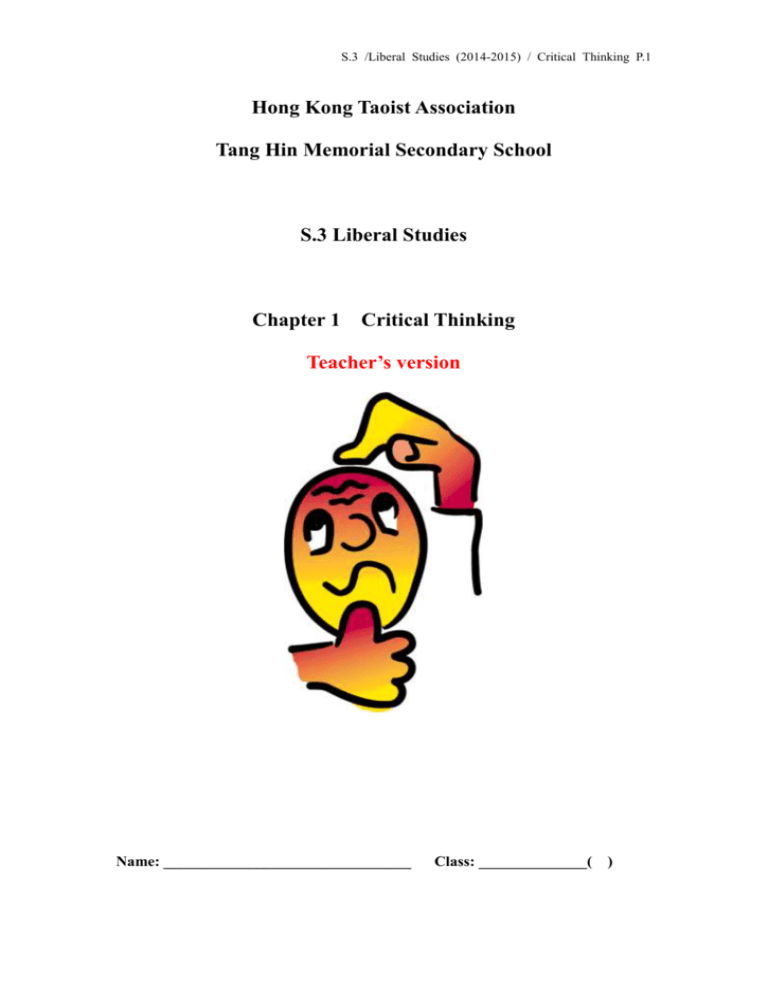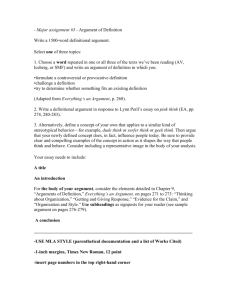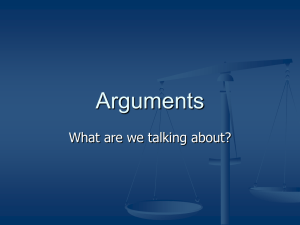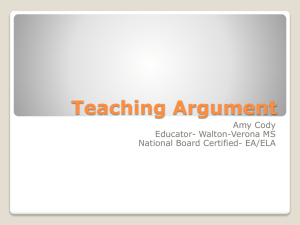S3 critical thinking notes(15
advertisement

S.3 /Liberal Studies (2014-2015) / Critical Thinking P.1 Hong Kong Taoist Association Tang Hin Memorial Secondary School S.3 Liberal Studies Chapter 1 Critical Thinking Teacher’s version Name: ________________________________ Class: ______________( ) S.3 /Liberal Studies (2014-2015) / Critical Thinking P.2 1. What is Critical Thinking (批判思考)? Critical thinking refers to clear and reasonable thinking. Critical thinking is the use of thinking skills and strategies to arrive at an ideal result. We can use critical thinking to evaluate and analyse arguments, to calculate likelihood, to make important decision and to solve problem. (Ku, Hau & Ho., (2009), Package on “The learning and teaching of critical thinking skills” (Senior Secondary), Personal, Social and Humanities Education Section, C.D.I., E.B.) REVISION: 5 steps in critical thinking The following are the steps in critical thinking. Rearrange them in correct order. A. Identify any logical fallacies in the argument. 找出論述中的謬誤。 B. Clarify the meaning of the wordings in the argument 釐清關鍵語言的意思 C. Identify the issue, the conclusion and the reasons supporting the conclusion. 確認議題、結論和支持結論的理由。 D. Decide whether to accept, reject or suspend judgment on the argument. 對論述作出判斷 (接納、否決或是未能作出判斷) E. Evaluate the credibility of the argument. 評估理由和證據的可信度。 C B E A S.3 /Liberal Studies (2014-2015) / Critical Thinking P.3 2. Identify the issue, the conclusion and the reasons supporting the conclusion A. What is an issue (議題)? Before we decide whether to accept or reject an idea, we should first identify the issue being discussed. An issue is an important question that is in dispute. Different people may have different views over an issue. They often try to persuade others to agree with them. B. Argument (論述), Reasons (理由) and Conclusion (結論) After identifying the issues being discussed, we have to find out the arguments of the speaker or writer. Argument = Reason(s) + Conclusion Example 1: All human will die. Tim is a human. Tim will die. Argument Conclusion Reasons: Tim will die. All human will die. Tim is a human. An argument is a claim that people put forward and defend with reasons. The claim that is supported is called the conclusion of the argument. The reasons are used to provide support to the conclusion. Conclusion is the “what” in an argument. It tells the reader or listener what to believe and what to do. There are words and expressions which usually indicate conclusions. The following are some examples of conclusion indicators: Therefore, In conclusion … Thus … As a result, So E.g. Based on the above reasons, you should work hard in school. conclusion indicator conclusion If the conclusion is the “what” of an argument, then reason is the “why”. Reason explains why a conclusion is right. Reasons explain why the readers or listeners should believe that the conclusion is right. The following are some examples of reason indicators: Because … The reasons are … Since … E.g. Because Eason Chan is a pop singer, there are many singers who wish to imitate his style. reason indicator reason conclusion S.3 /Liberal Studies (2014-2015) / Critical Thinking P.4 3. Clarify the meaning of the wordings in the argument A. Clarifying the meaning of the wordings After identifying the issues and the arguments being discussed, we have to make sure we understand the meaning of the key wordings used. For example, if people are discussing the issue of setting the minimum wage laws, we have to understand the meaning of ‘minimum wage’ first. Besides, we have to check whether the arguments contain any linguistic pitfalls. B. Linguistic pitfalls (語言陷阱) Some people use wordings with obscure meaning (含糊不清的措辭) or even distort the meaning of words in order to mislead or confuse others. These are called linguistic pitfalls (語言陷阱). We must be very careful to avoid being trapped by them. 1. Obscurity (語意不清) The following are two types of obscurity (語意不清). (i) Incomplete meaning (闕義) E.g.1 Hong Kong people are impolite. Does it mean that all Hong Kong people are impolite? Or most of the Hong Kong people are impolite? Or just some of the Hong Kong people are impolite? The meaning of this sentence is incomplete here. (ii) Vagueness (含混) A term is vague if it has an imprecise boundary. E.g.2 If you get good results in your examination, I will take you to the Disneyland. Different people have different definitions on ‘good results’. Full mark is absolutely good and zero mark is undoubtedly bad. How about the marks in-between? The term ‘good’ and ‘bad’ do not have clear boundaries. Thus, the meaning of ‘good results’ is vague. S.3 /Liberal Studies (2014-2015) / Critical Thinking P.5 2. Distortion (概念扭曲) Distortion means using words in such a way that deviates from its standard meaning. E.g. 3 Teacher: You did not get an ‘A’ because you were not hardworking. Student: But I was studying all the time and slept for only 5 hours a day. Teacher: No. If you were really hardworking, you would have got an ‘A’. The teacher here distorted the meaning of hardworking as getting an ‘A’. In fact, hardworking means trying one’s best but does not guarantee that he will get an ‘A’. 3. Empty Content (言辭空廢) Empty content means any statement that aimed to provide information, but in fact it provides no information at all. E.g. 4 It may rain tomorrow or it may not. E.g. 5 Anything that is large is not small. E.g. 4 looked like predicting something. In fact, it stated all the possibilities only. E.g. 5 is also an empty statement. It used the opposite of large to explain what is large. However, if a student is learning English and does not know the meaning of large, then the answer ‘anything that is large is not small’ provides some useful information. In such case we should not say that the answer is empty. C. Identifying the linguistic pitfalls Read the following statements. Identify the linguistic pitfalls if any. State the type and explain briefly. 1. The weather is getting cold because the temperature is dropping. Type Empty content Explanation The conjunction “because” is used to link the reason and conclusion. However, in this statement, the meaning of “weather is getting cold” is exactly the same as “temperature is dropping”. That means the reason and conclusion here are exactly the same. So, the statement does not provide any information, 2. An employee of Company X, “Many people will lose their jobs if our company goes to bankruptcy. Therefore, based on the consideration of public interests, the government should provide financial assistance to our company.” Type Distortion Explanation He distorted the meaning of “public interest” as “the interest of the employees in company X.” The standard meaning of public interest should be the interest of the whole society. S.3 /Liberal Studies (2014-2015) / Critical Thinking P.6 4. Evaluate the credibility of the argument A. Evaluate the credibility of the argument In the process of critical thinking, we have to identify the issues and the arguments being discussed first. We should clarify the meaning of the key wordings used and check whether there are any linguistic pitfalls afterwards. Then, we have to check whether the arguments and conclusion are credible. B. 1. Deductive argument (演繹論證) and inductive argument (歸納論證) Read the following arguments. Underline the reasons and put a square around the conclusion. Argument A: Gas expands when heated. X is a gas. Therefore, X expands when heated. Argument B: If it rains, the streets will be wet. The streets are wet now. It must have just rained. Argument C: All humans have three stomachs. Dolly is a human. Dolly has three stomachs. Argument D: I went every part of the world to collect a certain number of lemons. I collected 10000000000 lemons in total and found that all these 10000000000 lemons tasted sour. Thus, I believe that all lemons taste sour. Argument E: I caught a small fish in this pond yesterday. Today, I caught a small fish again in this pond. Therefore, I believe that all the fishes in this pond are small. 2. Arguments A, B, C are deductive arguments. (a) Which of the arguments, A, B or C, must be true? A (b) Explain why the other two are not true. Argument B: In the first sentence, ‘it rains’ is the cause and ‘the streets will be wet’ is the consequence. ( I mark ) However, in the second part , of the argument, the cause and consequence are reversed. ( 1 mark ) There may be other reasons that caused the streets wet. E.g. the streets have just been washed. ( 1 mark ) S.3 /Liberal Studies (2014-2015) / Critical Thinking P.7 Argument C: The first statement ‘all humans have three stomachs’ is not a fact. So, the argument is not true. 3. Arguments D and E are inductive arguments (a) Which of the arguments, D or E, is more probably true? .D (b) Explain your answer. Argument D: the number of lemons collected is large (large sample size) and the lemons are collected from different parts of the world. On the other hand, only two fishes were caught in argument E. We cannot draw a general conclusion from such a small size of sample. 4. DISCUSSION: What are the differences between deductive and inductive arguments? DEDUCTIVE INDUCTIVE Deductive reasoning is a method to deduce a certain conclusion from general rules. (由普遍到特殊) Inductive reasoning is a method to find a general rule from a large number of particular examples. (由 個別到一般) If all the reasons in a deductive argument If all the reasons in an inductive are true, then the conclusion _________ argument are true, then the conclusion must be is probably _______________ true. ____________________________ true. Practice: Are these inductive or deductive arguments? 1. All fishes breathe with gills. Salmons are fishes. They breathe with gills. Deductive 2. All the swans in France are observed as white. All the swans in Germany are also observed as white. Then, all swans in the world are white in colour. Inductive S.3 /Liberal Studies (2014-2015) / Critical Thinking P.8 C. Evaluating deductive arguments We can evaluate deductive arguments based on two criteria: 1. Validity (對確度) of deductive argument A deductive argument is valid (對確的) if it is deductively correct, .i.e. IF all the reasons are true, the conclusion MUST BE true. Which of the deductive arguments on p.6 are valid? A,C Rewrite the invalid deductive argument on p.6 into a valid one. Argument B: If it rains, the streets will be wet. It has just rained, the streets are wet now. 2. Soundness (對當度) of deductive argument A sound (對當的) deductive argument is a VALID argument with ALL the reasons being TRUE. Which of the deductive arguments on p.6 are sound? A Which of the deductive arguments on p.6 is valid but unsound? Rewrite it into a sound one. Argument C. All humans have one stomach. Dolly is a human. Dolly has one stomach. Practice: Evaluate the validity and soundness of the statements below. Valid? 1. If he loves me then he gives me flowers. He gives me flowers. So he loves me. 2. If it rains, the streets will be wet. If the streets are wet, accidents will happen. Therefore, accidents will happen if it rains. Sound? Invalid Unsound Valid Unsound A good deductive argument must be sound (valid and with all reasons that are true). S.3 /Liberal Studies (2014-2015) / Critical Thinking P.9 E. Evaluating inductive arguments We can evaluate inductive argument based on its strength. Strength (強度) of inductive argument Strong inductive argument is an inductive argument in which if all the premises are true then the conclusion is probably true than false. (a) Which of the inductive arguments on p.13 is a stronger inductive argument? Argument D. (b) Rewrite arguments D and E into stronger arguments. Argument D: change the word ‘all’ into ‘most of the’. Argument E: change the word ‘all’ into ‘some of’. A good inductive argument must be strong and all the reasons supporting the conclusion must be true. Practice: 1. If there is a lack of government assistance, life will be difficult for farmers. The farmers find life difficult, so there must be a lack of government assistance. (a) Is this a deductive or inductive argument? A deductive argument _____________________________ (b) If it is a deductive argument, is it valid? Explain briefly. OR If it is an inductive argument, is it strong? Explain briefly. “Lack of government assistance” is the cause while “life will be difficult for farmers” is the consequence. ( 1 mark ) In the second statement , the cause and the consequence are reversed ( 1 mark ) There is another cause like weather which farmers” ( 1 mark ) may cause “life will be difficult for S.3 /Liberal Studies (2014-2015) / Critical Thinking P.10 Therefore, it is an invalid argument (deductively wrong). ( 1 mark ) 2. All the fish John has caught in the river have weighed more than 100 pounds. So, most of the fish in the river weigh more than 100 pounds. (a) Is this a deductive or inductive argument? An inductive argument _____________________________ (b) If it is a deductive argument, is it valid? Explain briefly. OR If it is an inductive argument, is it strong? Explain briefly. We do not have enough information to decide whether it is strong or not. The strength of this argument depends on the number of fishes John has caught (i.e. the sample size) and the total number of fishes in that river (i.e. the population size). If John has caught a large proportion of the fishes in the river, then argument X is a strong one. (Strength is directly proportional to sample size) 5. Identify any logical fallacies in the argument A fallacy is a mistake in logical reasoning. (謬誤是指思維方式上的錯誤) The study of fallacies is an important part of critical thinking. Understanding fallacies help us to avoid them. It also helps us to better explain others’ mistakes in their arguments. We may divide fallacies into four categories: (李天命博士的「四不架構」) Fallacies of inconsistency (不一致謬誤) These are cases where something inconsistent or self-defeating has been proposed. (思考或言論有矛盾衝突、自我推翻、不一致等性質) E.g. When the former chief executive Mr. Tung was asked to comment a TV program. He said, ‘I shall not comment on such distasteful program.’ Fallacies of inappropriate presumption (不當預設謬誤) S.3 /Liberal Studies (2014-2015) / Critical Thinking P.11 These are cases where we have an assumption or a question presupposing something that is not reasonable to accept. (把不能視為當然的假設視為當然) E.g. E.g. Your friend asked you ‘Have your father succeeded in breaking from the jail?’ Fallacies of irrelevance (不相干謬誤) These are cases where irrelevant reasons are being used to support the conclusion. (理由和結論沒有邏輯關係,甚至毫無關連) E.g. Sam is a bad person. So, Sam’s argument must be wrong. Fallacies of insufficiency (不充分謬誤) These are cases where the evidence supporting a conclusion is insufficient or weak. (理由給結論的支持未達足夠有效的程度) E.g. The girls in my class are weak in critical thinking. Probably all girls are weak in critical thinking. Practice: Are these arguments? If these are arguments, are there any fallacies? 1. I buy these pills because the superstar Joey says that it helps prevent H7N9 influenza. (a) An argument Not an argument (b) Committed the fallacy of No fallacy Not applicable irrelevance ______________________________ (c) Explanation: Joey is not a medical expert. Her opinion is irrelevant to the effectiveness of the pills. 2. Are you bored with the speeches given by those politicians? Then vote for me/ Don’t forget, vote for me, David Chan. (a) An argument Not an argument (b) Committed the fallacy of No fallacy Not applicable ______________________________ (c) Explanation: This is not an argument, because the sentence just expresses an appeal and has neither a reason nor a conclusion. S.3 /Liberal Studies (2014-2015) / Critical Thinking P.12 3. We do not allow teenagers under the age of 18 to drink alcohol because they are too young. (a) An argument Not an argument (b) Committed the fallacy of No fallacy Not applicable inappropriate presumption / ______________________________ insufficency (c) Explanation: The statement assumes that age under 18 is young and young people should not drink. However, it does not explain why young people should not drink.OR This is an empty statement. The reason does not support the conclusion and OR merely repeats the conclusion. / The reason that they are too young is insufficient. There should be more explanations like people under the age of 18 cannot have good self- control or their internal organs are not fully developed to cope with the problems caused by alcohol. 4. The government should spend less on education, otherwise Hong Kong people will not be able to enjoy medical improvement (a) An argument Not an argument (b) Committed the fallacy of No fallacy Not applicable inappropriate presumption ______________________________ (c) Explanation: This argument is based on the assumption that the government can only choose between spending money on either education or medical improvement. People are distracted from the fact that there may be other alternatives e.g. spend more on both education and medical improvement and less on something else. 5. I met some students from Tanghin yesterday, who were very polite. I think all students from that school must be well-behaved. (a) An argument Not an argument (b) Committed the fallacy of No fallacy Not applicable insufficiency ______________________________ (c) Explanation: The students he met yesterday may not be sufficient to represent all students in Tanghin. This is over-generalisation. 6. One thing that we know for certain is that nothing is ever true or false. (a) An argument Not an argument Inconsistency S.3 /Liberal Studies (2014-2015) / Critical Thinking P.13 (b) Committed the fallacy of No fallacy Not applicable ______________________________ (c) Explanation: If there is something we know for certain, then there is at least one truth that we know. So it can't be the case that nothing is true or false. inconsistency S.3 /Liberal Studies (2014-2015) / Critical Thinking P.14 6. Decide whether to accept, reject or suspend judgment on the argument When we are asked to solve a problem, comment an opinion or discuss an issue, we should not make our judgment too early. We can only make sensible and rational judgment after careful analysis and evaluation. Step 1 to 4 is a process of analysis and evaluation. A. Summary issue Step 1: Identify the ________, conclusion and the the _______________ reasons supporting the _________________________ conclusion. _________________________. Checkpoint: What is an issue? What is an argument? Step 2: Clarify the meaning of the wordings in the argument. Checkpoint: What are linguistic If the context is not an issue or contains no argument, it is meaningless evaluate its credibility. E.g. The moonlight tonight is as gentle as you. This is just an expression of emotion. It is meaningless to say whether the statement is right or wrong. pitfalls? How many types of linguistic pitfalls have you learnt? credibility Step 3: Evaluate the ____________________ of the argument. If some of the keywords cannot be suspend clarified,our wejudgment, should _______ _________________________. E.g. Hong Kong people are impolite. Checkpoint: How many types of arguments have you learnt? How should we evaluate the arguments? Step 4: Identify any logical fallacies have you learnt? Can you Step 5: Decide whether to accept reject _____________, ___________ suspend or _______________________ give some examples for each type? on the argument. fallacies in the argument. Checkpoint: How many types of You may choose to accept, reject or suspend judgment at any point in the process of critical thinking. Critical thinking is a process of analysis and evaluation. We can only make sensible and rational judgment after careful analysis and evaluation. S.3 /Liberal Studies (2014-2015) / Critical Thinking P.15 7. Writing counterarguments Counterargument refers to the one or several additional argument(s) used to refute the reason(s) that support the conclusion, so that the readers understand certain opposite opinions. In the argument process, we sometimes deliberately add in some counterarguments, not for overturning the original arguments, but to let our readers understand that we have comprehensively considered some opposite arguments and opinions. Example: Rock-climbing is good for the personal development of young people. Some people say that rock-climbing looks rather dangerous. Young people may not have enough skill and safety awareness when they go rock climbing. They may injure themselves easily. However, I do not agree with the above view. Rock climbing can also be safe. If the apparatus are carefully checked and protective measures are taken, one can enjoy the fun of it without worrying about its safety. Also, Rock-climbing is challenging and builds self confidence as well as improving one’s physique. It is a good way for young people to improve their personal development. Is rock-climbing good for the personal development of young people? (a) What is the issue? ___________________________________________________ yes (b) Does the writer support rock-climbing? __________________________________ (c) What are his arguments? Argument 1: Conclusion: Rock climbing can also be safe Reasons If the apparatus are carefully checked and protective measures are taken, one can enjoy the fun of it without worrying about its safety. Argument 2: Conclusion: Reasons It is a good way for young people to improve their personal development. Rock-climbing is challenging and builds self confidence as well as improving one’s physique. (d) What is his counterargument? Conclusion: Rock-climbing looks rather dangerous. Reasons Young people may not have enough skill and safety awareness when they go rock climbing. They may injure themselves easily. (e) Why should we add in a counterargument? Let our readers understand that we have comprehensively considered some _____________________________________________________________________ opposite arguments and opinions. _____________________________________________________________________ S.3 /Liberal Studies (2014-2015) / Critical Thinking P.16 Practice: 1. Do you agree with the following statement? Please provide at least 2 arguments and 1 counterargument. “The government should guarantee that local kids get places of kindergartens in their own district.” Agree points: - Local families have contributed to Hong Kong society, such as paying tax and working in Hong Kong. - Local students have the right to education in the nearby district. - It is time consuming for local students to study in other district and affects their learning and health. - Even though mainland students have a lower priority in getting places in the kindergartens in North District, it does not violate their right to education as they can still apply kindergartens in all other districts. Counterargument: Some people say that Reasons: Argument 1: Conclusion: However, Reasons supporting your conclusion: Argument 2: Conclusion: Reasons supporting your conclusion: Disagree points: - The students from mainland are also Hong Kong citizens. They should have the same rights for Hong Kong residents. - The travelling time for the mainland students is longer than that for local students. Therefore the policy may also affect their learning and health. - The criteria of getting into a kindergarten should depend on the abilities of students, not where they live. S.3 /Liberal Studies (2014-2015) / Critical Thinking P.17 FURTHER READINGS 1. 2. 3. 4. 5. 《批判思考》 。香港:齡記出版社。 思方網 http://philosophy.hku.hk/think/chi/ (中) 李天命著: 《語理分析的思考方法》 。香港:青年書屋,1981 年。 李天命著: 《李天命的思考藝術》(終定本)。香港:明報出版社,1995 年。 李天命著: 《哲道行者》 。香港:明報出版社,2005 年。 GLOSSARY 1. Critical thinking 批判思考 2. 3. 4. 5. 6. 7. 8. 9. 10. 11. Issue Argument Reason Reason indicator Conclusion Conclusion indicator Linguistic pitfall Obscurity Incomplete meaning Vagueness 議題 論述 理由 理由指示符 結論 結論指示符 語言陷阱 語意不清 闕義 含混 12. 13. 14. 15. 16. 17. 18. 19. 20. 21. Distortion Empty content Credibility Deductive argument Inductive argument Validity Soundness Strength Logical fallacy Fallacy of inconsistency 概念扭曲 言辭空廢 可信度 演繹論證 歸納論證 對確度 對當度 強度 邏輯謬誤 不一致 22. 23. 24. 25. 26. Fallacy of inappropriate presumption Fallacy of irrelevance Fallacy of insufficiency Suspend judgment Analyze 不當預設 不相干 不充分 暫緩作出判斷 分析 評估 用來反駁的論點 27. Evaluate 28. Counterargument







